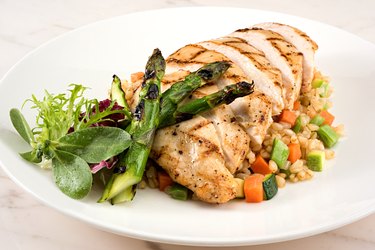
Chicken, whether fried crispy, roasted golden brown or served grilled, beats beef as the meat most eaten in the United States. A lot of that chicken comes from birds that are designated "fryers," young fowl that average 3.5 pounds in weight.
Chicken Sizes and Weights
Video of the Day
The U.S. Department of Agriculture recognizes six classifications of chicken. All are descendants of birds domesticated in India around 2000 B.C.
Video of the Day
- Broiler/fryers
are young chickens that weigh between 2.5 and 4.5 pounds after processing. They
can be used in any chicken recipe. Supermarkets may label whole chickens that
weigh around 5 pounds as fryers.
- Rock Cornish game hens are young chickens that weigh between 1 and 2 pounds. Because of
their size, game hens are usually stuffed and cooked whole.
- Roasters are
a few weeks older than fryers and game hens and weigh at least 5 pounds. Roasters
are meatier and, as the name suggests, usually roasted.
- Capons are male
chickens that are 4 to 8 months old and weigh between 4 and 7
pounds. Like roasters, they're meatier and are usually roasted.
- Stewing hens
are older, between 10 months and 1.5 years old. Since they're older, they tend
to be tougher and are usually prepared by cooking in liquid.
- Roosters are
mature male chickens with tough meat that requires long cooking.
Whole-Chicken Recipes
Chef Thomas Keller brines the chicken before roasting it, ensuring a moist bird. Make a brine of water and salt seasoned with fresh herbs, garlic and peppercorns. Place a whole fryer in a large zip-top or oven bag and pour the brine over. Refrigerate for six to eight hours. Remove the chicken from the brine, pat it dry and roast it at 475 degrees Fahrenheit for 45 to 50 minutes or until the internal temperature reaches 165 degrees Fahrenheit.
Julia Child's butter-roasted chicken doesn't require brining. Heat the oven to 425 degrees Fahrenheit. Tie the legs together with kitchen twine and tuck the wings under the back. Brush the chicken with butter and roast breast-side up for 15 minutes. After 15 minutes, brush the chicken with butter again and reduce the oven temperature to 350 degrees Fahrenheit. Continue roasting for an hour or until the internal temperature reaches 165 degrees Fahrenheit, basting occasionally.
To grill a whole chicken, truss the legs, season with salt and pepper and place it over indirect heat on the grill. Close the grill and cook the chicken breast-side up for 50 minutes or until the internal temperature reaches 160 degrees Fahrenheit. Let the chicken rest for about 10 minutes.
Cut-Up Chicken Recipes
Air fried: Air fryers are countertop convection ovens that cook food with hot air circulated by high-speed fans. If you overcrowd an air fryer, the food won't cook evenly, so they're best used for small batches. To keep chicken from drying out, coat it with your favorite batter or breading. Boneless breasts and wings take about 25 minutes, and thighs take 25 to 28 minutes.
Deep fried: For basic deep-fried chicken, dip chicken pieces in a mixture of beaten eggs and water and then dredge them in seasoned flour. Drop them into 350-degree oil and fry for 13 to 14 minutes for dark meat or 8 to 10 minutes for white meat.
Boneless chicken: Endlessly versatile boneless chicken can be tucked into fajitas, tossed in a salad, stir fried or ground into healthy meatballs. Saute it in oil until it's cooked through or season it and broil it. Grill it whole or cut it up for skewers, poach it in stock for chicken-noodle soup or bake it in a casserole. Remove the skin for low-calorie dishes or deep fry the skin for crunchy cracklings.
Chicken-Handling Safety
Bacteria can be present in raw or undercooked chicken, but you can avoid foodborne illness or cross-contamination of other foods by following a few food-safety practices. Cook poultry to an internal temperature of 165 degrees Fahrenheit. An inexpensive instant-read kitchen thermometer takes the guesswork out of checking chicken temperatures.
Wash your hands and surfaces that have come into contact with raw poultry. Wash your cutting board and knives before using them for preparing other foods. Keep raw chicken separate from other foods to avoid cross-contamination.
Use chicken within two days or freeze it in its original packaging. If you plan to freeze chicken for longer than two months, wrap the package with foil or freezer paper or put it in a freezer bag. Use whole frozen chicken within a year and frozen chicken parts within nine months. Don't rinse raw chicken before preparing it. You run the risk of splashing bacteria in the sink or on the drain board.
- United States Department of Agriculture Food Safety and Inspection Service: Chicken from Farm to Table
- The New York Times: Does the Air Fryer Deliver on Its Golden Promise?
- WorldAtlas: How Much Meat Do Americans Eat?
- Our Harvest: Thomas Keller’s Simple Roasted Chicken
- Food & Wine: Julia’s Favorite Roast Chicken
- Food & Wine: Whole Grilled Chicken with Wilted Argula
- Food Network: Southern Fried Chicken